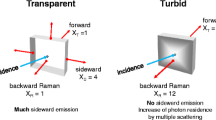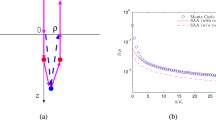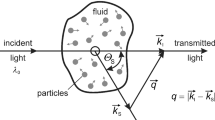Abstract
Raman intensities from reflection (X R ) and transmission (X T ) setups are compared by calculations based on random walk and analytical approaches with respect to sample thickness, absorption, and scattering. Experiments incorporating strongly scattering organic polymer layers and powder tablets of pharmaceutical ingredients validate the theoretical findings. For nonabsorbing layers, the Raman reflection and transmission intensities rise steadily with the layer thickness, starting for very thin layers with the ratio X T /X R = 1 and approaching for thick layers, a lower limit of X T /X R = 0.5. This result is completely different from the primary irradiation where the ratio of transmittance/reflectance decays hyperbolically with the layer thickness to zero. In absorbing materials, X R saturates at levels that depend strongly on the absorption and scattering coefficients. X T passes through a maximum and decreases then exponentially with increasing layer thickness to zero. From the calculated radial intensity spreads, it follows that quantitative transmission Raman spectroscopy requires diameters of the detected sample areas be about six times larger than the sample thickness. In stratified systems, Raman transmission allows deep probing even of small quantities in buried layers. In double layers, the information is independent from the side of the measurements. In triple layers simulating coated tablets, the information of X T originates mainly from the center of the bulk material whereas X R highlights the irradiated boundary region. However, if the stratified sample is measured in a Raman reflection setup in front of a white diffusely reflecting surface, it is possible to monitor the whole depth of a multiple scattering sample with equal statistical weight. This may be a favorable approach for inline Raman spectroscopy in process analytical technology.

Raman spectroscopy in turbid matter














Similar content being viewed by others
References
Salzer R, Siesler HW (eds) (2009) Infrared and Raman spectroscopic imaging, 1st edn. Wiley, Weinheim
Buckley K, Matousek P (2011) Recent advances in the application of transmission Raman spectroscopy to pharmaceutical analysis. J Pharm Biomed Anal 55:645–652. doi:10.1016/j.jpba.2010.10.029
Wikström H, Lewis IR, Taylor LS (2005) Comparison of sampling techniques for in-line monitoring using Raman spectroscopy. Appl Spectrosc 59(7):934–941
Kalantri PP, Somani RR, Makhija DT (2010) Raman spectroscopy: a potential technique in analysis of pharmaceuticals. Der Chemica Sinica 1:1–12
Johansson J, Sparen A, Svensson O, Folestad S, Claybourn M (2007) Quantitative transmission Raman spectroscopy of pharmaceutical tablets and capsules. Appl Spectrosc 61:1211–1218. doi:10.1366/000370207782597085
Sparén A, Johansson J, Svensson O, Folestad S, Clayborn M (2009) Transmission Raman spectroscopy for quantitative analysis of pharmaceutical solids. Am Pharmaceut Rev 62–71
Gao X, Jehng J-M, Wachs IE (2002) In situ UV–vis–NIR diffuse reflectance and Raman spectroscopic studies of propane oxidation over ZrO2-supported vanadium oxide catalysts. J Catal 209(1):43–50. doi:10.1006/jcat.2002.3635
Eliasson C, Matousek P (2007) Noninvasive authentication of pharmaceutical products through packaging using spatially offset Raman spectroscopy. Anal Chem 79(4):1696–1701. doi:10.1021/ac062223z
Stone N, Baker R, Prieto CH, Matousek P (2008) Novel Raman signal recovery from deeply buried tissue components. In: Mahadevan-Jansen A, Petrich W, Alfano RR, Katz A (eds) Biomedical optical spectroscopy. Proceedings of SPIE. SPIE-OSA, p 68530N. doi:10.1117/12.786442
Srinivasan S, Schulmerich M, Cole JH, Dooley KA, Kreider JM, Pogue BW, Morris MD, Goldstein SA (2008) Image-guided Raman spectroscopic recovery of canine cortical bone contrast in situ. Opt Express 16(16):12190–12200
Matousek P (2006) Inverse spatially offset Raman spectroscopy for deep noninvasive probing of turbid media. Appl Spectrosc 60(11):1341–1347
Eliasson C, Macleod NA, Jayes LC, Clarke FC, Hammond SV, Smith MR, Matousek P (2008) Non-invasive quantitative assessment of the content of pharmaceutical capsules using transmission Raman spectroscopy. J Pharm Biomed Anal 47:221–229. doi:10.1016/j.jpba.2008.01.013
Hargreaves MD, MacLeod NA, Smith MR, Andrews D, Hammond SV, Matousek P (2011) Characterization of transmission Raman spectroscopy for rapid quantitative analysis of intact multi-component pharmaceutical capsules. J Pharm Biomed Anal 54:463–468. doi:10.1016/j.jpba.2010.09.015
Nah S, Kim D, Chung H, Han S-H, Yoon M-Y (2007) A new quantitative Raman measurement scheme using Teflon as a novel intensity correction standard as well as the sample container. J Raman Spectros 38(5):475–482. doi:10.1002/jrs.1667
Oelkrug D, Brun M, Rebner K, Boldrini B, Kessler RW (2012) Penetration of light into multiple scattering media; model calculations and reflectance experiments. Part I: the axial transfer. Appl Spectrosc 66(8):934–943. doi:10.1366/11-06518
Matousek P, Clark IP, Draper ERC, Morris MD, Goodship AE, Everall N, Towrie M, Finney WF, Parker AW (2005) Subsurface probing in diffusely scattering media using spatially offset Raman spectroscopy. Appl Spectrosc 59(4):393–400
Oelkrug D, Brun M, Hubner P, Egelhaaf H-J (1996) Optical parameters of turbid materials and tissues as determined by laterally resolved reflectance measurements. Proc SPIE 2925:106–115. doi:10.1117/12.260831
Schrader B, Bergmann G (1967) Die Intensität des Ramanspektrums polykristalliner Substanzen. Fresenius J Anal Chem 225(2):230–247. doi:10.1007/bf00983673
Matousek P, Parker AW (2006) Bulk Raman analysis of pharmaceutical tablets. Appl Spectrosc 60(12):1353–1357. doi:10.1366/000370206779321463
Everall N, Matousek P, MacLeod N, Ronayne KL, Clark IP (2010) Temporal and spatial resolution in transmission Raman spectroscopy. Appl Spectrosc 64:52–60. doi:10.1366/000370210790571963
Everall N, Priestnall I, Dallin P, Andrews J, Lewis I, Davis K, Owen H, George MW (2010) Measurement of spatial resolution and sensitivity in transmission and backscattering Raman spectroscopy of opaque samples: impact on pharmaceutical quality control and Raman tomography. Appl Spectrosc 64:476–484. doi:10.1366/000370210791211646
Matousek P (2007) Raman signal enhancement in deep spectroscopy of turbid media. Appl Spectrosc 61(8):845–854
Oelkrug D (1994) Fluorescence spectroscopy in turbid media and tissues. In: Lakowicz JR (ed) Topics in fluorescence spectroscopy, vol 4. Plenum Press, New York, pp 223–253. doi:10.1007/0-306-47060-8_8
Allen E (1964) Fluorescent white dyes: calculation of fluorescence from reflectivity values. J Opt Soc Am 54(4):506–514
Oelkrug D, Kortüm G (1968) Zur Berechnung der Lumineszenzreabsorption bei pulverförmigen Substanzen. Zeitschrift für Physikalische Chemie NF 58:181–188. doi:10.1524/zpch.1968.58.1_4.181; see also Kortüm G (1969) Reflectance Spectroscopy, Springer, Berlin
Fukshansky L, Kazarinova N (1980) Extension of the Kubelka–Munk theory of light propagation in intensely scattering materials to fluorescent media. J Opt Soc Am 70(9):1101–1111
Gade R, Kaden U (1990) True luminescence spectra and luminescence quantum yields of molecules adsorbed on light-scattering media. Part 1.—theory. J Chem Soc Chem, Faraday Trans 86(22):3707–3712
Oelkrug D, Brun M, Mammel U (1994) Spatial fluorescence profiles in multiple light scattering systems. J Lumin 60–61:422–425. doi:10.1016/0022-2313(94)90181-3
Kubelka P (1948) New contributions to the optics of intensely light-scattering materials. Part I. J Opt Soc Am 38(5):448–448
Oelkrug D, Brun M, Hubner P, Rebner K, Boldrini B, Kessler RW (2012) Penetration of light into multiple scattering media: model calculations and reflectance experiments. Part II: the radial transfer. Appl Spectrosc 66(8):934–943
Koenig JL, Boerio FJ (1969) Raman scattering and band assignments in polytetrafluoroethylene. J Chem Phys 50(7):2823–2829
Peacock CJ, Hendra PJ, Willis HA, Cudby MEA (1970) Raman spectrum and vibrational assignment for poly(tetrafluoroethylene). J Chem Soc Inorg Phys Theor 2943–2947
Rabolt JF, Fanconi B (1978) Raman scattering from finite polytetrafluoroethylene chains and a highly oriented TFE-HFP copolymer monofilament. Macromolecules 11(4):740–745. doi:10.1021/ma60064a025
Legeay G, Coudreuse A, Legeais J-M, Werner L, Bulou A, Buzaré J-Y, Emery J, Silly G (1998) AF fluoropolymer for optical use: spectroscopic and surface energystudies; comparison with other fluoropolymers. Eur Polym J 34(10):1457–1465. doi:10.1016/s0014-3057(97)00289-9
Bratescu MA, Saito N, Takai O (2006) Treatment of immobilized collagen on poly(tetrafluoroethylene) nanoporous membrane with plasma. Jpn J Appl Phys, Part 1 45:8352–8357. doi:10.1143/jjap.45.8352
Acknowledgment
We thank Kaiser Optical Systems for the allocation of a RamanRXN1™ system.
Author information
Authors and Affiliations
Corresponding authors
Rights and permissions
About this article
Cite this article
Oelkrug, D., Ostertag, E. & Kessler, R.W. Quantitative Raman spectroscopy in turbid matter: reflection or transmission mode?. Anal Bioanal Chem 405, 3367–3379 (2013). https://doi.org/10.1007/s00216-013-6719-2
Received:
Revised:
Accepted:
Published:
Issue Date:
DOI: https://doi.org/10.1007/s00216-013-6719-2




